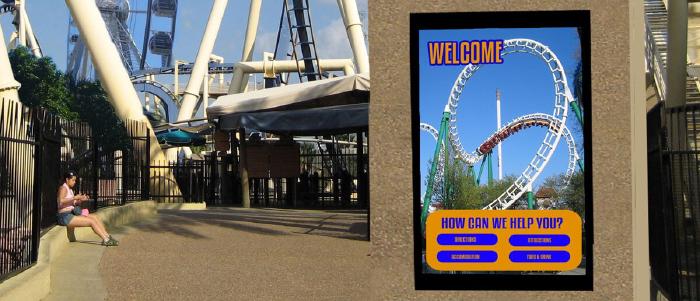
Nov 9 2023
5 min read

A Deloitte survey singled out poor in-stadium navigation as one of the major factors contributing to poor customer experience.
Therefore, when it comes to hosting successful sports events, providing a seamless customer experience is paramount. One crucial aspect that significantly impacts both customer satisfaction and revenue potential is sports stadium wayfinding.
Modern-day digital wayfinding signage solutions are dynamic and flexible, creating a highly unique and seamless navigation experience. From digital directional signs to self-catered interactive premise maps, visitors at football stadiums and other gaming arenas can be introduced to new-gen wayfinding.
In this article, we’ll explore 16 actionable ways you can leverage sports stadium wayfinding to optimize customer experience and boost your revenue potential.
With crowds entering in thousands, stadiums need to deploy an efficient wayfinding solution. Here are some of the best ideas to make the most of these solutions.
Digital signage solutions have emerged as powerful tools for sports stadium wayfinding, offering numerous benefits to both fans and venue operators.
A) Efficient Crowd Management
The software powering these screens can adapt to changing conditions within the stadium, offering alternative routes or redirecting traffic to avoid congestion.
For instance, if a particular entrance or pathway becomes crowded, digital displays can instantly update directions to suggest less crowded alternatives, optimizing fan flow and reducing bottlenecks.
B) Interactive Maps

Digital signage displays can also feature interactive maps of the stadium, allowing fans to explore and find their desired locations. Users can interact with the display to zoom in/out, swipe across different sections, and even search for specific amenities or seating areas. This intuitive interface simplifies the navigation process and helps fans easily locate restrooms, concessions, exits, or their seats.
Try For FreeC) Parking Assistance
Digital sports stadium wayfinding screens can further assist fans to find parking areas by showing real-time parking spot availability updates. By integrating parking management systems, these displays can indicate the number of available parking spots in different lots or direct fans to alternative parking options when certain areas are full.
Ensure your stadium wayfinding accommodates individuals with disabilities. You can incorporate braille signage, wheelchair-friendly routes, and audio direction guides to create an inclusive environment.
The Mercedes-Benz Stadium in Atlanta achieved ADA compliance by installing inclusive wayfinding systems like ADA shuttle service at Parking Lots and LED sign boards that offer closed captions on announcements, resulting in improved accessibility ratings.
Develop a stadium app with interactive maps and personalized wayfinding features. Besides wayfinding, mobile apps also allow fans to access find amenities, purchase products and explore exclusive content.
The San Francisco 49ers’Levi’s Stadium app garnered over 1 million downloads and significantly boosted in-app purchases. Visitors can use the app for turn-by-turn directions within the stadium premises, game replays with multiple angles, express services at the stadium concession stands and more.

Directional signs that lead fans towards merchandise stores and concession stands act as visual cues, guiding fans along a specific pathway. The strategic placement of these signs can direct fans’ attention towards these areas, increasing the likelihood of them following the designated path and exploring the offerings along the way.
Fans attending sporting events like football & basketball often experience a heightened sense of excitement. You can utilize your stadium wayfinding touchpoints to increase the stadium turnovers.
Strategically positioning your wayfinding signage near merchandise stores and concession stands can drive impulse purchases. For example, displaying images of fans enjoying snacks while wearing team merchandise can create a desire to replicate that experience.
Digital wayfinding signage can also tap into the fans’ FOMO (fear of missing out) on exclusive or limited-time offers. By showcasing limited edition merchandise, time-limited discounts with a countdown timer ticking on digital screens, sports arenas can create a sense of urgency and exclusivity, thus driving sales.
The Fenway Park in Boston increased merchandise sales by 15% by installing directional signs near team stores.
5. Leverage Augmented Reality (AR)
Integrate Augmented Reality features into your stadium app to provide interactive wayfinding experiences. AR overlays can guide fans in real-time, offering virtual paths and highlighting points of interest.
The Melbourne Cricket Ground implemented AR wayfinding during the 2019 ICC Cricket World Cup, enhancing the fan experience.
Your sports stadium wayfinding signage and digital displays are valuable advertising real estate. Digital signage software like Pickcel lets you optimally utilize your screen space through custom screen layouts. This means stadiums can divide their digital signboard screens into multiple zones and play a variety of content simultaneously.
Stadiums can rent their digital wayfinding screen’s real estate to sponsors and merch sellers, boosting brand exposure and generating additional revenue streams.
One of the biggest benefits of turning your sports stadium wayfinding signs digital is that you get the capability to collect and analyze crowd data.
You can leverage data from ticketing systems or loyalty programs to offer personalized wayfinding experiences. Provide custom directions, preferred routes, and tailored recommendations based on individual fan preferences.
The Golden 1 Center in Sacramento personalized wayfinding based on fan data, resulting in increased fan engagement and satisfaction. The stadium helped visitors enjoy seamless through an app. In the backend, the app uses the data from Wi-Fi access points and Bluetooth Beacons to analyze queue lengths and estimated wait times.

Integrating emergency wayfinding protocols is crucial for ensuring fan safety during critical situations in stadiums.
The digital signage software can be integrated with the can be integrated with stadium-wide emergency management systems, such as fire alarms or public address systems. When triggered, these systems can automatically override the regular content and display emergency alerts and notifications in real-time.
The emergency wayfinding displays can mark the nearest exits, evacuation routes, and first aid stations, etc.
The sport stadium wayfinding systems can also help to assess crowd reactions and the efficiency of the crowd management staff through simulations. By utilizing the displays to simulate emergency scenarios, stadiums can conduct training exercises for staff and educate attendees on the appropriate responses during emergencies.
Integrate emergency wayfinding protocols to ensure fan safety during critical situations. Clearly mark emergency exits, evacuation routes, and first aid stations.
Many stadiums have adopted tailored wayfinding experiences for for premium seating areas, such as luxury suites or VIP lounges.
Digital wayfinding signage screens can serve as a platform for personalized concierge services. For example, the displays can showcase personalized welcome messages (using facial recognition), highlight exclusive amenities, or provide information about premium services available to VIP ticket holders.
The Emirates Stadium in London offers dedicated wayfinding for VIP ticket holders, elevating their experience
You can also leverage digital wayfinding signs at VIP guest areas to boost the stadium revenues.
How?
By featuring targeted advertisements (such as ads for luxury products & services) and showcasing upcoming VIP events.
For international events or diverse fan bases, provide multilingual stadium wayfinding options to accommodate different languages. Translate your signage and app content to ensure all fans can easily navigate the premises.
Sports stadium wayfinding is a powerful strategy that can significantly impact customer experience and revenue potential. By implementing the above ideas, including clear signage, digital displays, personalized experiences, and data-driven improvements, you can optimize navigation, engage fans, and unlock additional revenue streams.
Looking for a powerful digital signage solution for your sports stadium wayfinding management? Pickcel can be the right fit for you. Schedule a free demo session with our experts and learn about the umpteen possibilities.

Nov 9 2023
5 min read

Oct 1 2023
7 min read

Jul 17 2023
9 min read

Aug 9 2022
8 min read
Take complete control of what you show on your digital signage & how you show it.
Start Free Trial Schedule My DemoHotel Signage Isn’t About Screens, but About Smarter Operations. See How JW Marriott Used Pickcel to Modernize the Guest Experience
Unlock Exclusive Insights